Archive for category Colorado Politics
More Bad News for Colorado’s Public Pensions
Posted by Joshua Sharf in PERA, Taxes on September 9th, 2013
Another month, another report showing the country’s pension problem to be worse than we thought, Colorado’s pension problem to be among the nation’s worst. This time, it’s a report from the non-partisan State Budget Solutions, “Promises Made, Promises Broken – The Betrayal of Pensioners and Taxpayers.”
In three significant measures, Colorado ranks in the bottom third of the nation’s public pensions: Its funded ratio is the 11th-lowest in the country, at 32.8%; the per capita unfunded liability is 15th-worst, at $16,158 per head; and as a percentage of the state’s GDP, Colorado is 16th-highest, at just over 31%. These dire rankings corroborate a recent Moody’s study that had Colorado’s unfunded pension liability in the bottom 10 as a percentage of state government revenues, another measure of the state’s ability to cover these debts.
They calculate the actual unfunded liability at just under $84 billion, nearly four times what PERA admits to, and $27 billion more than is estimated in an upcoming Independence Institute report. It should be noted, however, that the authors include five plans managed by the state’s Fire and Police Pension Association, much smaller plans which are not part of PERA.
The report takes issue with most public pensions’ investment return expectations, which usually vary between 7% and 9%, and the aggressive discounting oliabilities that most plans engage in. Instead of the optimistic – some would say wildly optimistic – return assumptions, the report’s authors use 3.225%, the 15-year Treasury rate. They also use that number to discount plans’ liabilities, arguing correctly that the discount rate should reflect a plan’s risk to its investors, not its returns on its investments. They argue that since these plans approach being risk-free investments, they should be discounted as such.
Personally, I think both the return assumption and the discount rate are too low. Even if 8% is unrealistic, and I’m not sure that it is, funds tend to have their money in diversified portfolios which will average returns higher than Treasuries. In addition, the plans are covered by state obligations, not federal ones. Investors have long recognized that state obligations carry more risk than do federal “risk-free” obligations, a fact reflected in the higher interest rates carried by state debt.
That said, the study makes two useful contributions to the debate. By making the return and discount assumptions it has, the report effectively sets an upper bound on the problem; surely no lower interest or discount rates could reasonably be chosen.
More concretely, by showing us to occupy the same neighborhood as such well-known pension basket cases as New Jersey and California, the report shows the foolishness of the approach of Amendment 66 – raising taxes, while appropriating all of the increased short-term revenue to ongoing operations.
Why Rhonda Fields Is Worse Than Wrong
Posted by Joshua Sharf in Colorado Politics, Economics on August 23rd, 2013
In a committee hearing yesterday, State Senator Vicki Marble found herself on the wrong end of a Rep. Rhonda Fields race-baiting attack. Marble – in a committee hearing devoted to race- and ethnicity-based sources of and effects of poverty – had the temerity to suggest that there might be some cultural and dietary contributors to poverty in certain groups. In reality, this isn’t even a particularly controversial statement. It was said without malice, and African American State Rep. Tony Exum, who spoke immediately after Marble, apparently didn’t even react. It was only Fields who went nuts, supposedly taking offense, attacking Marble, posing as a victim of racism – in a meeting devoted to racial disparities in poverty rates.
Fields is the one who deserves to be condemned here. Not because she’s effectively played the ever-popular race card for partisan political reasons, but because she’s hurting the very people whom we all agree need help the most, while pretending to defend and support them.
Let’s be clear – it is a dangerous and socially destabilizing situation when a group of people believes that it’s denied participation in the fruits of the American dream because of their race. It is fundamentally unfair and indecent to the extent that it turns out to be true. There is every reason for the state government to take an interest in the welfare of its citizens, especially the poorest and most vulnerable. And there is every reason for a state to try to determine the extent to which actual, real, discrimination exists.
Which is why Rep. Fields’s outburst is so reprehensible. Instead of identifying areas where Blacks and Hispanics might be able to take their destiny into their own hands, she actively encourages them to think of themselves as victims, nurse grievances, and tend to resentments. Instead of looking for actual sources of discrimination, she invents reasons for outrage. Instead of finding ways that people can lift themselves off the Safety Net, she is more interested in keeping them enmeshed in it.
In Detroit, in spectacular fashion, we’ve seen where this leads.
Rep. Fields has no business serving on such a committee.
And anyone who truly cares about the welfare of poor African Americans and Hispanics should stand up and say so.
Access Denied
Posted by Joshua Sharf in PERA on August 5th, 2013
Ed News Colorado reports on last Thursday’s State Appeals Court ruling denying State Treasurer Walker Stapleton access to dereferenced PERA data for high-salaried members:
Stapleton, a Republican, is a vociferous critic of the current PERA structure. The state treasurer is automatically a member of the 16-member PERA board. First elected in 2010, Stapleton in 2011 asked the board for access to individual records (without names) of the top 20 percent of PERA retirees, based on pension amounts.
High-dollar pensions have been something of a fixation for GOP critics of PERA, even though the average monthly benefit paid by the system is $3,020. Most PERA members aren’t eligible for Social Security. The PERA system covers all Colorado teachers and many higher education employees.
That last paragraph requires some rebuttal. High-dollar pensions are a fixation in large part because the rest of the PERA board decided to go to the mattresses to keep the information from being released. One might just as easily ask why keeping high-dollar pensions secret is something of an obsession for PERA.
That said, there are some excellent reasons for wanting to examine PERA’s high-dollar pensions.
First, at least some of those pensions come from teachers’ union reps, who are frequently no longer doing work for their school district, and instead are working exclusively for the union. The status of the Douglas County Federation of Teachers (DCFT) union rep became a major point of contention during open negotiations, mostly because she would have continued to accrue PERA benefits, even though the union offered to pay both her salary and her personal PERA contribution. With a $1 billion tax increase likely to be on the ballot this fall, and with much of the opposition to that tax increase based on the fact that about half of it would go to fund teachers pensions rather than classrooms, non-teaching union reps receiving outsized pension benefits would be embarrassing both for PERA and for tax increase supporters.
The other reason for concern over high-dollar pensions is the agency problem surrounding the PERA board itself. Most of the board are PERA members, and many receive high salaries, and so will be eligible for high-dollar pensions when they retire. With the PERA board having opposed recent attempts at reorganization, so that fewer board members are voting on their own benefits, the last thing they want is for attention to be focused on those benefits.
From a political point of view, it also makes sense for Treasurer Stapleton to try to split PERA beneficiaries between the average member and the high dollar recipient. While the PERA board and its allies have a history of resisting attempts to limit benefits overall, or to change the benefit calculation formula, a graphic demonstration of the actual distribution of benefits could lead many average PERA recipients to rebel against leadership, and accept limits at the high end of the scale. From the board’s point of view, that would be an ominous development.
While the Appeals Court has decided that Colorado taxpayers are not entitled to this information about their senior government employees, there is yet hope that the State Supreme Court will decide differently.
UPDATE: An earlier version of this post mistakenly attributed the ruling to the State Supreme Court.
Real Returns and Solvency – Part I
Posted by Joshua Sharf in PERA on August 4th, 2013
One of the biggest problems with the way that pension plans report their solvency numbers is the assumption of constant returns over the life of the plan. By assuming constant returns, plans end up hiding the single biggest factor in why they’re likely to go bust: risk. This post will try, with a hugely (and unrealistically) simplified example, to illustrate the problem this poses when trying to figure out whether a plan has enough money to cover its liabilities.
For this first cut, the aspect I want to capture is that with mandatory annual outflows, a pension fund puts itself at risk of falling behind, and never being able to catch up.
Let’s take this example: a $1,000,000 liability, timed to last 30 years, with $250,000 annual payouts, and payments into the fund that are calculated based on the expected return on assets. Here’s what the fund balance will look like if we assume a constant 8% return on assets:

Payments into the fund each year are calculated to be a little over $161,000 a year in order to make this happen. Also note that all this is being conducted in real dollars; we’re ignoring inflation, which is going to drive some people up the wall, but 1) we can always make a calculation in real dollars, 2) there’s really no good way of predicting inflation over a 30-year span, and 3) this is a thought exercise.
Where can I get an 8% a year return for 30 years? Well, I could put it in bonds that return 8%, but those may not always exist. Right now, we have a low-interest rate environment, and even corporate bonds that are highly-rated don’t necessarily return 8%. Surely investment-grade municipal bonds don’t get me 8% at 30 years. And remember, I need to find a place to put each year’s inflow, so by the end of the 30 years, I’m unlikely to find a 1-year corporate or municipal bond that pays me 8%, absent a pretty severe inflationary environment.
One investment that is liquid, that also provides reliable 30-year returns over 8%, is the S&P 500 index of large-cap US stocks. The S&P has been around since 1926. So starting in 1955, we have 30-year return profiles for it. Here’s the distribution of annualized 30-year returns for the S&P 500, from 1955 – 2011:

The thing has never returned less than 8.5% over that time, and averages 11.76% (although the median is lower). This is a period of time that covers a World War, a Depression, inflation, the Korean and Vietnam Wars, the 2000 Tech Bubble Burst, and the 2008 Real Estate Bubble Burst. That’s a pretty good track record.
Here’s the rub. Here are the annual S&P 500 returns over that time:

Not so good. You have a pretty good chance of losing money; in 11 years out of 85 you’d be down 10% or more, and in 6 of those years, down 20% or more. In three of those years, you’d lose 35% or more of your total investment. You can see the problem: the risk of running one really bad year, or a couple of moderately bad years, early on, where you might have to spend your seed corn, is high enough to be worrisome, even if the total 30-year return is comfortably higher than your planning.
In order to see our imaginary fund’s chances of making to 30 years solvent, we need to put in not a constant 8% return, but a random variable that looks like the S&P 500 annual return. Surprisingly, there’s considerable debate over whether or not such a variable is even possible to construct. The returns are clearly not normally distributed, and adding more moments (skewness, how fat the tails are, etc.), doesn’t produce unique random variables. When you look at the returns, it also looks as though the year-to-year returns may not really be independent, either; that is, a losing year seems to follow another losing year.
Given all this debate, I just figured that, with 57 separate 30-year runs available to us, the easiest thing to do would be to use those 30-year runs themselves. I.e, 1956 – 1985, 1957 – 1986, etc. Here’s a pretty typical return profile:

One really bad year, a couple of downers soon after, but positive almost all the time, and a number of eye-popping returns of over 40% to make up for it. Should work out, ok, right?
Not so much:

The actual balance in the account falls below the projection in Year 9, and never really is able to gain altitude again. By Year 20, the fund is bust, and has to either get bailed out or stop making payments.
What’s interesting is that it’s not the Year 6 Catastrophe that does the fund in. Given the good years that preceded it, the balance after Year 6 is right at the projected levels. A fund manager could easily persuade himself that everything’s going to be ok. What really causes the problem is the two bad-but-not-disastrous Years 9 and 10 consecutively. The S&P comes back in consecutive years with 20%, 25%, 20%, 35%, and it’s still not enough to put any real air between the balance and the ground. So by Year 15, when the S&P loses less than 10% – less than it had lost in any of the previous losing sessions – it’s effectively all over.
How often does this happen? Well, here are the failure rates for various return assumptions, starting with the average of 11.76% that the S&P actually returns, and going to 7%, for the ultra-conservative fund manager:

The manager who doesn’t leaving himself any breathing room cashes out over 60% of the time, which might be a little surprising. It’s not until we assume a 10% return (corresponding to annual pay-ins of $143,000), that we get to a 50-50- chance of seeing 30 years. Our 8% manager still fails over a quarter of the time, and it’s not until we get past a 7% assumed return (pay-ins of $169,000) – where we’re effectively giving up 40% of the actual S&P historical return in our planning, that we almost get to an 80% chance of solvency in Year 30.
Now, to be clear, you don’t end up in such bad shape most of the time that you don’t go bust. You’re often well in the black. For the fund manager who’s planning on 7%, he ends up over $10,000,000 in the black over a third of the time. So often, when you win, you win really big.
But in pensions as in baseball, you can’t spend those winnings from other timelines. The Cardinals beat the Reds 15-2 today, but tomorrow, it’s 0-0 when the pitcher takes the mound. My concern as a pensioner is being able to plan on a certain amount of money coming my way after I retire. If the plan goes bust when I’m 75, it’s too late for me to make other plans. And if the plan ends up with an extra $9,000,000 on-hand when I’m 80, there’s not much benefit in that, either. The cost of losing is very, very high; the unlikely rewards from extra winnings don’t make up for that, which is why I put my money into a “safe” pension plan in the first place.
Understand, as stated at the outset, this is a hugely simplified example, on about 100 different levels. Real pension plans don’t consist of a single individual. They generally don’t make payouts at the same time they’re collecting contributions. The lifetime of the plan for an individual is longer than 30 years. Their portfolio is more diversified than putting everything in US stocks. Inflation actually matters to pensions, possibly for benefits, certainly for wage calculations.
But the basic point – that the actuarial assumptions of flat returns, assumptions that fail to take into account risk as well as reward – are serious planning flaws that can ultimately lead to a plan’s demise.
My hope is, over time, to make these models more complex, remove some of the simplifications, give something approaching actual likelihoods of Colorado’s PERA going bust, and ultimately, create an online model where you, the reader, can enter your own assumptions and see what happens to PERA’s long-term prospects. That’s a big project, and it’s going to take a long time to complete. But there’s nothing in the finish product that isn’t here in the basic principles: returns move around all over the place, and the cost of providing ownership in a liability rather than an asset can be ruinous.
The PERA Fire Sale, The Gift That Keeps On Taking
Posted by Joshua Sharf in PERA on August 1st, 2013
Over at the Denver Post, Vince Carroll details the price that PERA has been paying for its “fire-sale” of pension benefits from 2001-2005:
There are many PERA beneficiaries like Coffman who bought years of service — often at a very advantageous discount — and who now receive pension checks larger than you would expect based upon the span of their careers.
A large number of those transactions occurred over a three-year period a decade ago, when “PERA conducted what one executive called, in retrospect, a ‘fire sale’ on the service credit,” according to a 2005 analysis by the Rocky Mountain News.
The administration of Gov. Bill Owens, in a major blunder, lobbied for the fire sale as a shortsighted way to encourage early retirement and infuse new blood into the bureaucracy.
As Carroll notes, this problem was known as early as 2005, when David Milstead of the late, lamented Rocky wrote about it:
But the deal got sweeter. Gov. Bill Owens, then in the early part of his first term, wanted to streamline government and bring new employees into the state work force. In 2000, with his encouragement – some say pressure – PERA cut the already-low price of purchasing extra years by 14 percent, to 15.5 percent of salary.
Owens said he doesn’t recall the specifics of what was said to PERA, but “I thought it was valuable to have the flexibility to get new employees into some of the positions in the state bureaucracy.”
…
Service-credit purchases kicked up by 38 percent in 2001, topping $100 million.
PERA decided to raise the price back to 18.1 percent of salary for members under 50 and increase it to 22.1 percent for older members. But they told employees it wouldn’t happen until November 2003.
Given that window, thousands of employees raced to the sale.


It also calls to mind an excellent article by Josh Barro in National Affairs, “Dodging the Pension Disaster,” where he suggests a way (perhaps) to actually reduce the unfunded liability after a defined benefit-to-defined contribution transition:
A working paper by Maria Fitzpatrick, a fellow at the Stanford Institute for Economic Policy Research, attempts to determine just how highly some public employees value their pension benefits. She examined Illinois teachers’ choices when, in 1998, they were offered a chance to make a one-time payment up front in exchange for more generous benefits in retirement. The terms of the purchase varied significantly depending on a teacher’s salary and years of service. Using reasonable discount rates, the up-front purchase cost was lower than the present value of benefits for nearly all teachers — 99% could expect at least a 7% annual return on investment, with no risk so long as the state did not default. But the deal was sweeter for some teachers than for others, a variation that made it possible to estimate the subjective present value that teachers placed on future benefits.
Fitzpatrick’s finding is, in a way, depressing: On average, teachers were willing to pay only 17 cents on the dollar to obtain a pension-benefit increase. This suggests that defined-benefit pensions are a highly inefficient form of compensation, costing taxpayers far more than they are worth to public employees.
But it also suggests an appealing policy solution: Governments can offer to buy back promised pension benefits at a discount, and employees may be inclined to take the deal. Admittedly, the proposal presents a political problem to lawmakers, in that it requires them to produce an immense sum of cash up front in order to eliminate a long-term liability. To alleviate some of that pain, however, governments could responsibly issue bonds to raise the money — since this would mean simply substituting explicit debt for a larger amount of implicit pension debt. Governments would incur an obligation to pay interest on the bonds, but in most cases that amount would be more than offset by the reduction in required employer pension contributions.
In Colorado’s case, the price was about 15.5 cents on the dollar, but there was huge interest, so a fair price may be considerably higher than that. Add to that the fact that people are often less willing to let go of a perceived cash benefit than they are to buy it in the first place, and there’s reason to think we can’t possibly buy it back for 15.5%. Still, having a limited-time “open season” market, or Dutch auction, with a declining price, might be a way of disposing of some of the liability.
PERA’s the price for purchasing service credit has since returned to reasonable levels, we’ll be living with the cost of selling long-term debts cheaply for a long time to come. At this point, it’s almost impossible to tell how much of PERA’s long-term debt obligation comes from this sale; I can’t find aggregate numbers in the CAFR, and the charts above show only the price paid, not the goods sold, but it certainly warrants further investigation.
PERA’s Premature Celebration
Posted by Joshua Sharf in PERA on June 28th, 2013
This morning, the Denver Post carried a story about PERA’s “celebration” over a 12.9% return on its investments in 2012, and how it allegedly puts to the lie to State Treasurer Walker Stapleton’s concerns over the solvency of the pension plan.
Would that it were so, but PERA is, as usual, spiking the football on this one too early.
First, let’s start with the return itself. 12.9% is good, but it’s not exceptional, as PERA returns go. It’s above the 8% that they assume over the next 60(!) years, in order to get the funds to be solvent over that time, to be sure. And it’s only possible because a higher return means a higher volatility. As we’ve said before, PERA only needs to have a couple of bad years to fall so much further behind that it can’t catch up. This year’s modest gains in its funded levels could easily be wiped out by even a couple of average years that see positive returns in the 5% range.
As an aside, we should also note that PERA’s returns follow the returns of the much larger California pension system, CalPERS, almost exactly:
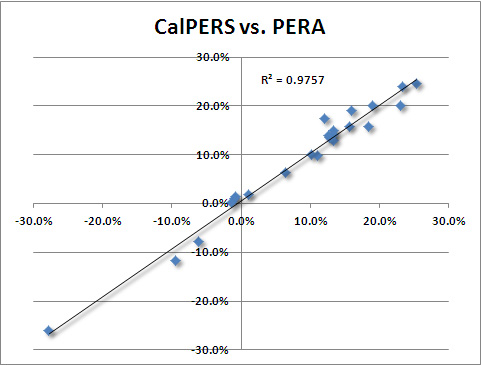
The 12.9% is below PERA’s self-imposed benchmark of 13.4% – with Alternative Investments doing the worst relative to its benchmark. It’s right at BNY Mellon’s Median Public Fund average return of 13.0%. And it’s right in line with what you’d expect, given CalPERS’s 13.3% this past year. If PERA is willing to declare victory for missing its own benchmarks, and doing just about as well as everyone else, we should perhsaps be asking what we’re actually getting for all that money management staff we’re paying.
Worst, though, is that PERA’s situation really hasn’t improved all that much, and remains far worse than they’re willing to admit. PERA discounts its liabilities using the expected rate of return on its investments, per the Government Accounting Standards Board (GASB) rules. There are a number of problems with doing this, first and foremost being that it encourages funds to take on more risk in order to appear better-funded. It’s also unsound financial economics. Every other pension rule in the world requires the fund to use its parent entity’s long-term cost of borrowing. In this case, that would be best approximated by Colorado Certificates of Participation, currently trading at 5.3% yield. PERA provides a sensitivity analysis of various discount rates, and it’s not too hard to extend it back to a rate of 5.3%. (There’s also a very slight change in the actuarial value of the assets; I’ve included that just for completeness).
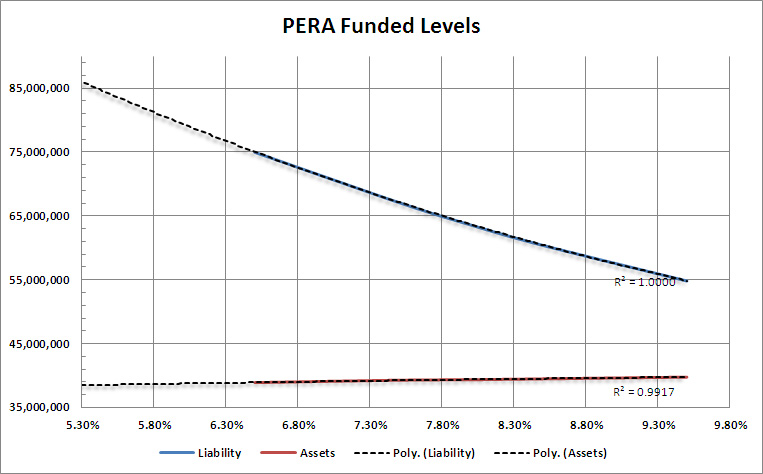
So basically, properly calculated, instead of having the unfunded liability of just over $24 billion that PERA admits to, it’s actually in the hole for about $47 billion, or about $23,500 per household. A more accurate number could be gotten with a more detailed analysis, but this is probably within a billion or two dollars, which suddenly doesn’t seem like all that much money.
PERA likes to claim that the actual unfunded liability doesn’t really matter all that much, since it can’t ever be called in tomorrow, but must wait until it’s actually due. Like so much else PERA says when it comes to its unfunded liability, this fundamentally misunderstands the nature of present value. The point isn’t whether or not a liability can be collected tomorrow. Present Value is just a means of comparing a future liability and present assets in today’s dollars, a way of asking how much you would pay today for the promise of the amount of the liability tomorrow (or whenever it’s due). It has nothing to do with whether or not such an immediate transaction is possible.
However, we can calculate how much the unfunded liability will mean to Colorado families when they have to make it up. Right now, a $23,500 debt, paid at PERA’s assumed return of 8% over 30 years, is about $2,000 per family, per year.
Save the champagne.
As relates to another story – PERA’s baleful effects on school budgets, the release of the CAFR gives us a chance to update our school spending charts. There’s some improvement in the growth rates, even as they continue to far outpace inflation. And in the School Division, the increase is coming entirely from the taxpayers.



The US Supreme Court’s Proposition 8 Ruling, and TABOR
Posted by Joshua Sharf in Budget on June 26th, 2013
Today, in its ruling on California’s Proposition 8, the Supreme Court ruled that citizens’ groups do not have standing to defend a law passed by referendum or initiative in federal court, should the state decline to do so. By making this reasoning the basis for its decision, the Court has potentially invited grave implications for Colorado and its Taxpayers Bill of Rights.
Currently, TABOR is the subject of a lawsuit arguing that it violates the US Constitution’s provisions that each state have a republican form of government:
The United States shall guarantee to every State in this Union a Republican Form of Government, and shall protect each of them against Invasion; and on Application of the Legislature, or of the Executive (when the Legislature cannot be convened), against domestic Violence.
ARTICLE IV, SECTION 4
The plaintiffs, which include five current Democratic state legislators, argue that, by removing the legislature’s ability to raise taxes without approval by the people, has violated that clause. That case is now in federal court, in front of the 10th Circuit Court of Appeals.
That assertion has been challenged on a number of counts. First, the federal courts have ruled that clause – the “Guarantee Clause” to be non-justiciable, leaving it instead as an issue for the political branches. Second, there is every reason to believe that the founders used the word “republican” to describe even systems of direct democracy.
Currently, with Gov. Hickenlooper named as respondent on behalf of the state, Colorado’s Attorney General, John Suthers, is defending TABOR on behalf of the state.
In the case today regarding Proposition 8, Hollingsworth v. Perry, the State had declined to defend Proposition 8 in court, despite its having been an approved referendum, and being the law of the State of California. The Supreme Court ruled that, in the absence of state defense, private citizens groups cannot do so in its stead. Once the state agrees with the plaintiffs, the court was essentially saying, there is no case.
The implications for Colorado’s TABOR case, and next year’s elections to succeed Suthers as Attorney General, are profound. While any or all of the Republican candidates can be expected to defend TABOR vigorously, the election of a Democrat would open the possibility that the Colorado Department of Law might decline to defend TABOR in federal court.
In the case involving the Defense of Marriage Act, the federal Department of Justice declined to defend DOMA in court, but the US House of Representative hired counsel to do so. If the Democrats were to retain control of both houses of the state legislature, it is highly unlikely that they would act to defend TABOR in this way.
If that were to happen, TABOR might be left without defense, and without any party with standing to conduct a defense. In short, a twenty-year-old state Constitutional Amendment, whose basic provisions have never been overridden on subsequent attempts at repeal or modification, could be killed by default.
Angela Giron, IRS Beneficiary
Posted by Joshua Sharf in Colorado Politics on June 4th, 2013
Well, what do we have here?
Colroado State Senator Angela Giron (D-Pueblo), facing a recall from voters in her district over her gun control votes in this year’s state legislature, has gotten considerably monetary help from outside sources in her bid to stay in office, the Pueblo Chieftain reports:
Giron, a Pueblo Democrat, is the target of a recall drive by Pueblo-area gun rights supporters and Republicans. Her defense campaign, called Puebloans for Angela, received a $35,000 contribution from the Sixteen Thirty Fund in Washington; a $20,000 contribution from a Denver organization called Citizens for Integrity; and a $15,000 contribution from a Denver group called Mainstream Colorado. (emphasis added – ed.)
The Sixteen Thirty Fund has been organized as a 501(c)4 since Feb. 16 of 2009 (we wonder how long it had to wait for IRS approval), according to its 2009 IRS Form 990, and its mission, as state on Page 2 of that documents is:
Sixteen Thirty Fund operates exclusively for the purpose of promoting social welfare, including, but not limited to, providing public education on and conducting advocacy regarding progressive policies.
The fund operated as a collector and distributor of over $3.3 million for various left-wing causes during 2009, including $52,000 to our very own Progress Now here in Colorado. It won’t come as any surprise that most of those groups, including ones that are clearly political organizations, are also organized as 501(c)4s.
Now, I don’t have any problem with these or any other groups organizing as 501(c)4s, if the law allows that. But it’s telling that Democrats have decided to turn the various IRS hearings into a trial of the tax law, one which they were perfectly happy to take full advantage of as long as the other side didn’t. Having kept Tea Party, conservative, and libertarian groups on the sidelines through two election cycles, they can now afford to be outraged at unfair treatment, and call for a revision of the law.
And of course, there’s this, from Senate President John Morse, fighting his own recall battle:
I intend to fight this – we cannot allow outside interest groups to determine what is best for Colorado. #coleg #copolitics #GunSafety
— John Morse (@SenJohnMorse) June 4, 2013
Who’s Panicking?
Posted by Joshua Sharf in PERA on May 15th, 2013
Last week, former PERA Executive Director Miller Hudson penned an op-ed for the Denver Post, arguing that PERA’s situation has improved to the point where we need not worry about it, and that no further tinkering with it is necessary (“There is no need for panicky ‘fixes’ to PERA“). Unfortunately for the taxpayers of Colorado, Mr. Hudson’s comforting conclusions are belied by some uncomfortable facts.
Let’s begin with where Mr. Hudson places the blame for the current funding problems. He identifies one of them correctly – overly generous benefits that amount to promises that cannot be kept, except at great expense. He is also correct that the dot-com bubble was fool’s gold for the legislature, which led it to create the overly-generous benefits.
But PERA’s portfolio managers (who predate Mr. Hudson’s tenure as Executive Director), allowed the fund’s investments to become dangerously overweight in volatile stocks, in effect letting their winning bets ride. When the dot-com bubble burst, so did PERA’s funded ratio, and it continued to decline throughout the decade, recovering only slightly in the mid-00s:
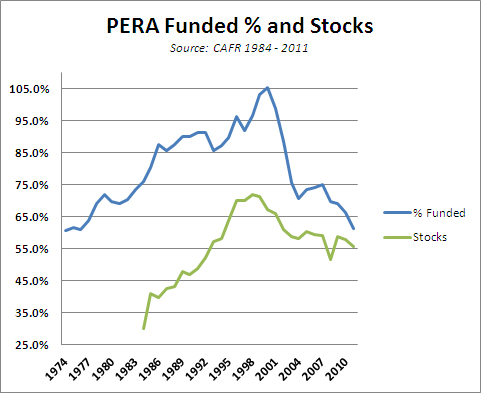
This chart also shows the folly of relying on long-term returns to determine a fund’s solvency. If a plan is underfunded, adding additional return may look like the way to catch up. But along with that additional reward comes additional risk and volatility. When the portfolio has a bad year, as in 2000, 2001, and 2008, it doesn’t have the option of drastically reducing its payout that year, as you or I would with our own retirement accounts. The need to pay benefits regardless of the fund’s annual return can put it in a hole that it can never recover from. PERA’s estimate of 8% may indeed be a realistic return over 30 or 40 years. But benefits need to be paid when they need to be paid, and the results of this thinking are all too obvious in the above chart.
And while the legislature rarely met its Annual Required Contribution (a contribution set by Government Accounting Standards Board, and designed to ensure actuarial soundness), this shortfall was only a relatively minor factor in the fund’s increasing unfundedness. According to the chart below, had the legislature made the ARC every year from 2000 on, the State and School Divisions, which comprise the overwhelming part of PERA, would only have been about $4 billion better-off last year. PERA admits to a $23 billion unfunded liability, although there is reason to believe it is much larger:
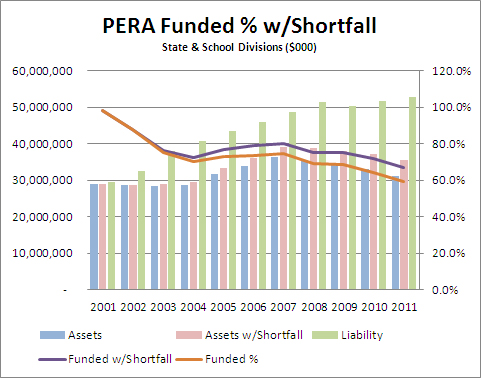
Mr. Hudson also argues that, because overall, PERA contributions account for less than 3% of public spending, the burden is light. This ignores that for many entities – school districts, in particular – PERA spending is eating up an increasing portion of their operating expenses:
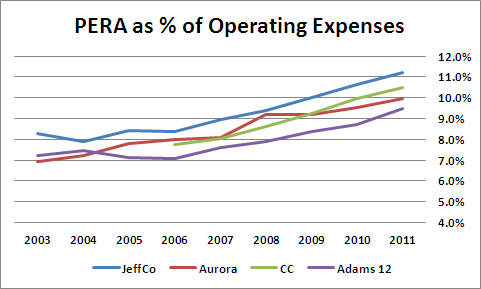
This is a result of the very supplemental payments (SAEDs) that are designed to save the system from ruin. PERA is correct that the supplemental payments were envisioned as being shared between the districts and their teachers. But with many, if not most, school boards under the thumb of the teachers’ unions, they have decided to have their districts absorb the entire supplemental payments. This means that as of 2011, for four major Denver-area school districts, roughly 11% of their operating expenses were going to teacher pension plans, money that could have gone into the classroom.
Mr. Hudson tries, implicitly, to discredit those who are concerned about PERA’s fiscal condition by claiming that it is only “in recent decades” that concern has grown up around the unfunded liability. While it is true that in the past, PERA has been significantly under-funded, two conditions make that of greater concern now. First, the PERA unfunded liability is much larger now as a percentage of the state GDP, meaning that should a fix become necessary, the pain to the state’s taxpayers will be considerable greater than it has been in the past. In the 1980s and early 90s, the unfunded liability hovered around an unthreatening 2% of state GDP. That has since grown to 9%:
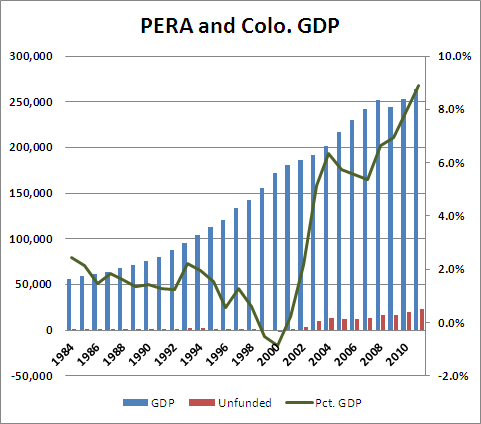
Second, since PERA has an unfunded liability, it means that some of its current expenses are paid for by current employees. (A fully-funded program would, by definition, have all current expenses in the bank.) The ratio of current employees to retirees has been falling for decades, as well, meaning that any increases in contributions will fall more heavily on future employees and future taxpayers:
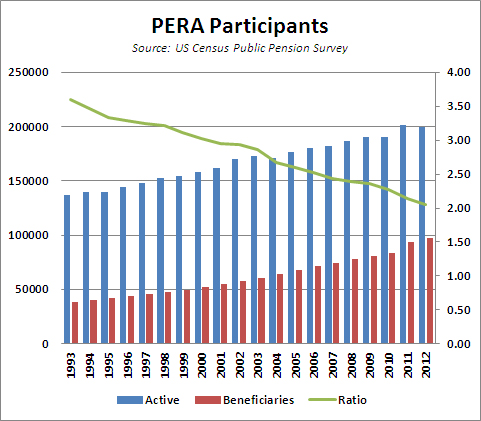
As part of his rhetoric, Mr. Hudson contrasts the concrete – and real – improvements from SB10-001 with unnamed and undescribed “fixes” proposed by those who worry about PERA’s financial condition. This leaves the reader to imagine all sorts of horribles. Let’s look at some of the “panicky” fixes proposed in the state legislature over the last several years:
- HB13-1040: Would have calculated benefits on the basis of seven, rather than three years’ pay, making “spiking” more difficult to achieve
- SB13-055: Would have applied the same liability discount rate rules to PERA as apply to US private pensions and European public pensions
- HB12-1142: Would have given all PERA members the option to join PERA’s own defined contribution plan
- HB12-1179: Would have broadened the composition of PERA’s board to reduce conflicts of interest and increase accountability
- SB12-016: Would have given local governments the same option the state government has to make plan members pick up more of their benefit contributions in times of fiscal distress
- HB12-1250: Would have calculated health care benefits on the basis of costs, rather than employees’ salaries
- SB12-082: Would have set the PERA retirement age to that of Social Security for non-public safety members, a matter of basic fairness
- SB12-119: Would have forced PERA make adjustments until its plans could meet a 30-year amortization window, the standard for pensions
- SB12-136: Would have included PERA benefits in the state’s Biennial Compensation Report
All of these changes are designed to increase transparency, increase accountability, and decrease conflicts of interest. All of them are designed to increase fairness, and increase the likelihood that PERA retirees will be able to rely on promises made to them.
It is telling that each of these changes – every last one – has been opposed by PERA and its allies in the public employees unions here in Colorado.
And it’s enough to make you wonder who’s really panicking.
Yes, PERA Is Worse Now
Posted by Joshua Sharf in PERA on May 14th, 2013
Defenders of PERA often argue that while the liabilities have been under-funded in the past, it is only now that PERA’s critics have begun to worry about the matter. The implied message is that the complaints are political, rather than financial. Here’s why this isn’t the case:

Yes, Colorado’s economy has grown, but the PERA liability has grown faster. While through the 80s and most of the 90s, the unfunded liability hovered around 2% of the state’s GDP, since 2000, it has grown to 9%. Of course, during the good economic years, it declined somewhat, and it may well decline a little again this year, as PERA’s returns are expected to be around 12% on its portfolio. But sooner or later, we will hit a cyclical recession, and even as the economy shrinks, PERA’s unfunded promises will continue to accumulate.



